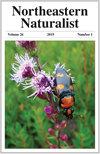Changes in Bald Eagle Nesting Distribution and Nest-Site Selection in Kentucky during 1986–2019
IF 0.5
4区 环境科学与生态学
Q4 BIODIVERSITY CONSERVATION
引用次数: 0
Abstract
Abstract – Kentucky's breeding Haliaeetus leucocephalus (Bald Eagle) population began recovering in 1986, with a single nest, and has since expanded from the state's western portion to the central and eastern regions. We used aerial survey data to describe the spatiotemporal distribution of Bald Eagle nests in Kentucky, to examine changes in nest-site selection relative to natural and anthropogenic features, and to create a nesting-habitat suitability model. Our results highlight increased nesting near developed areas in recent years. Although nests in these areas productively contribute to populations, we note some considerations of increased risks associated with nesting in developed areas. We also provide predictions of available nesting areas and data to direct the future monitoring and management of Bald Eagles in Kentucky.1986-2019年肯塔基州白头鹰筑巢分布和巢址选择的变化
摘要-肯塔基州的白头鹰种群于1986年开始恢复,只有一个巢穴,此后从该州西部扩展到中部和东部地区。我们使用航空调查数据来描述肯塔基州秃鹰巢穴的时空分布,研究巢穴选址相对于自然和人为特征的变化,并创建巢穴栖息地适宜性模型。我们的研究结果强调了近年来发达地区附近筑巢的增加。尽管这些地区的巢穴对种群数量有很大贡献,但我们注意到,在发达地区筑巢会增加风险。我们还提供了可用筑巢区域的预测和数据,以指导肯塔基州秃鹰的未来监测和管理。
本文章由计算机程序翻译,如有差异,请以英文原文为准。
求助全文
约1分钟内获得全文
求助全文
来源期刊

Northeastern Naturalist
环境科学-生态学
CiteScore
1.10
自引率
0.00%
发文量
42
审稿时长
18-36 weeks
期刊介绍:
The Northeastern Naturalist covers all aspects of the natural history sciences of terrestrial, freshwater, and marine organisms and the environments of the northeastern portion of North America, roughly bounded from Virginia to Missouri, north to Minnesota and Nunavut, east to Newfoundland, and south back to Virginia. Manuscripts based on field studies outside of this region that provide information on species within this region may be considered at the Editor’s discretion.
The journal welcomes manuscripts based on observations and research focused on the biology of terrestrial, freshwater, and marine organisms and communities as it relates to their life histories and their function within, use of, and adaptation to the environment and the habitats in which they are found, as well as on the ecology and conservation of species and habitats. Such studies may encompass measurements, surveys, and/or experiments in the field, under lab conditions, or utilizing museum and herbarium specimens. Subject areas include, but are not limited to, anatomy, behavior, biogeography, biology, conservation, evolution, ecology, genetics, parasitology, physiology, population biology, and taxonomy. Strict lab, modeling, and simulation studies on natural history aspects of the region, without any field component, will be considered for publication as long as the research has direct and clear significance to field naturalists and the manuscript discusses these implications.
 求助内容:
求助内容: 应助结果提醒方式:
应助结果提醒方式:


